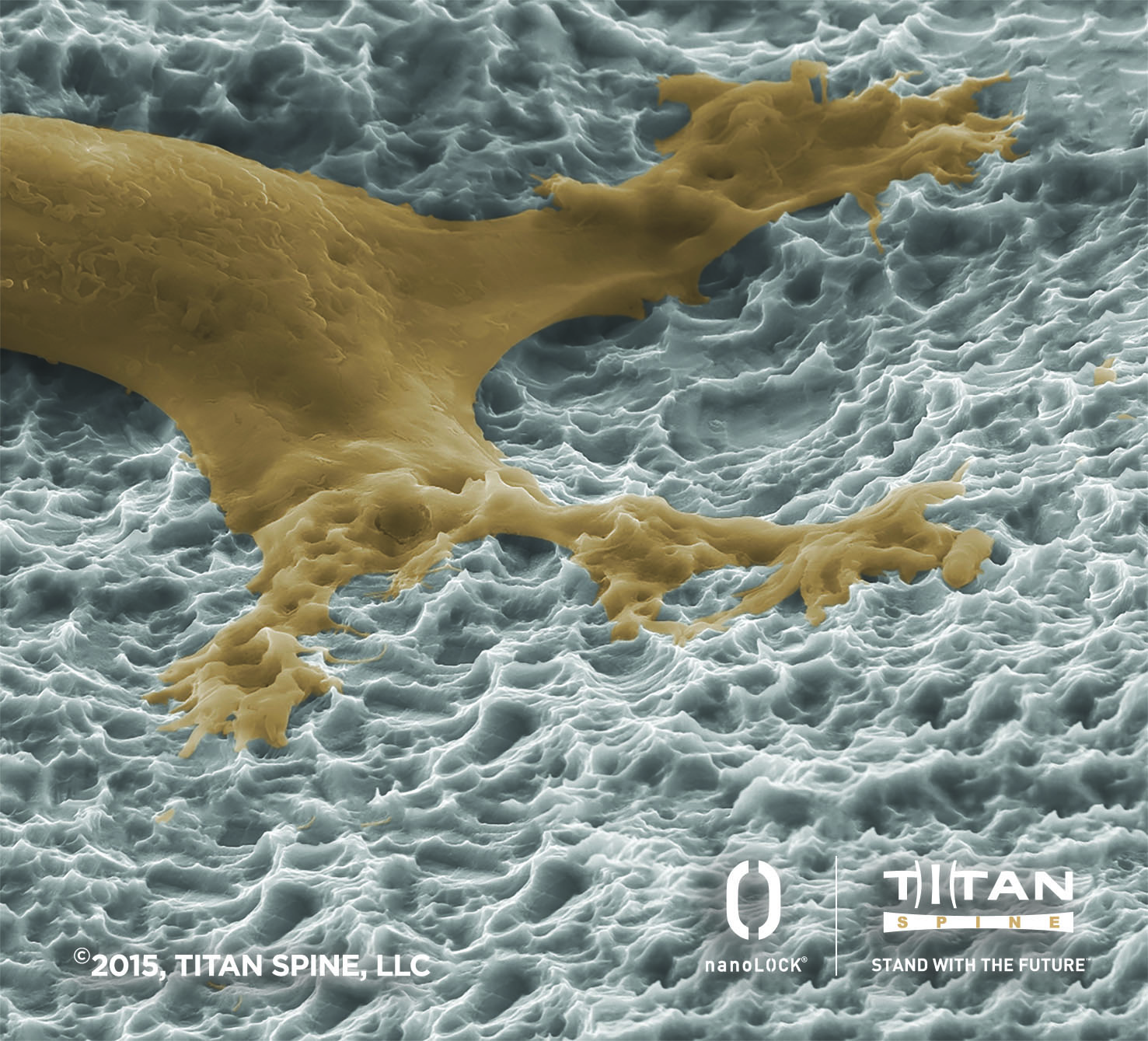Titan Spine’s nanoLOCK® surface technology helps patients heal faster, benefiting both patients and spine surgeons who, in the new era of pay-for-performance healthcare, are rewarded for faster healing with fewer complications, readmissions, revisions and other performance-based metrics.
 As medical advancements and patient care evolve, a fundamental shift is underway that is moving away from fee-for-service and toward pay-for performance healthcare that financially rewards faster healing with fewer complications, hospital readmissions, surgical revisions and so on. Subsequently, spine surgeons and hospitals are increasingly under the microscope. Titan Spine has developed a surface technology, called nanoLOCK®, to help improve early interbody fusion patient outcomes through the application of nanotechnology that ironically can only be seen under the microscope. It does so by prompting the patient’s natural bone growth mechanisms from virtually the moment it has been implanted.
As medical advancements and patient care evolve, a fundamental shift is underway that is moving away from fee-for-service and toward pay-for performance healthcare that financially rewards faster healing with fewer complications, hospital readmissions, surgical revisions and so on. Subsequently, spine surgeons and hospitals are increasingly under the microscope. Titan Spine has developed a surface technology, called nanoLOCK®, to help improve early interbody fusion patient outcomes through the application of nanotechnology that ironically can only be seen under the microscope. It does so by prompting the patient’s natural bone growth mechanisms from virtually the moment it has been implanted.
“The key to Titan Spine’s differentiation is its surface technology. The nanoLOCK® surface is revolutionary in that it interacts with the cell at a nanoscopic level, unlocking that natural response of cell surface receptors to produce various factors that encourage the growth of bone,” says Adam Bruggeman, MD, an orthopedic spine surgeon with the Texas Spinecare Center in San Antonio. “Through this groundbreaking technology, implants with the nanoLOCK® surface are able to speed up the host bone response, theoretically leading to improvements in patient outcomes and faster healing times.”
receptors to produce various factors that encourage the growth of bone,” says Adam Bruggeman, MD, an orthopedic spine surgeon with the Texas Spinecare Center in San Antonio. “Through this groundbreaking technology, implants with the nanoLOCK® surface are able to speed up the host bone response, theoretically leading to improvements in patient outcomes and faster healing times.”
On January 1 of this year, MACRA (Medicare Access & CHIP Authorization Act of 2015) went into effect. It is being driven by the Centers for Medicare & Medicaid Services (CMS) and mirrored by an increasing number of private insurers to reach a triple-aim goal to improve patient health, improve patient experience of care, and reduce the per capita cost of healthcare in a country encumbered with soaring U.S. healthcare spending totaling more than $3 trillion in 2015.1
MACRA created the Quality Payment Program which changed how CMS pays practices that provide care to Medicare beneficiaries, placing emphasis on quality care and improved patient outcomes. Physicians serving a large enough CMS population are now required to participate in the Merit-Based Incentive Payment System (MIPS).
This change has led the pivot from fee-for-service to pay-for-performance, effectively re-defining success when it comes to spine fusions. No longer are one- to two-year outcomes sufficient. Now, CMS and payers demand improved episode of care outcomes for the first 30 to 90 days post-op, while still maintaining positive long-term outcomes. No longer are CT/X-ray confirmation of fusion, long-term reduction in ODI and VAS, and general patient satisfaction enough. In this new era, care metrics include broader and cost-associated criteria that align with the triple aim objectives, including: complications, readmissions, pain reduction, infections, revisions, time to discharge, rapid symptomatic improvement, time to return to work, quality of life and cost, among others.
This pay-for-performance framework is geared toward linking surgeon compensation to these early patient outcomes.
So, what does MIPS mean for surgeons? MIPS now ranks surgeons among their peers nationally and reports scores publicly, adding a level of accountability to the mix. Surgeons are ranked on a 100-point scale on a composite of quality of care, the sharing of care information, and activities that are taken to improve care. MIPS is budget neutral and incentivizes high-performers funded by penalties applied to low-performers.
Financially, there is a lot at stake. In 2019, the lowest performers will be penalized 4 percent of their CMS income while the highest performers will be rewarded 4 percent. The adjustments increase to +/- 9 percent by 2022. Moreover, since these records will be publicly available via resources such as Propublica and SurgeonRatings.org, it means accountability and therefore reputation in the local community is on the line.
What can surgeons do to improve patient outcomes, achieve positive reputation, and reach financial incentives? Some may choose to modify patient selection, surgical skill sets or surgical approach. However, most physicians believe the easiest change to make relates to the products used in surgery and during the episode of care. Surgeons can embrace new technologies that are engineered to improve early post-op and long-term patient healing and recovery, and therefore increase the likelihood of improved community reputation and increased financial incentives on the winners’ side of the bell curve.
In terms of interbody fusions, there is a vast range of products available to surgeons. So how does a surgeon select an interbody fusion device that effectively stimulates a patient’s body to start growing bone and fuse as quickly as possible?
Titan Spine’s Endoskeleton® interbody devices featuring its nanoLOCK® surface technology takes advantage of a concept called biomimicry that leverages nature’s expertise in solving complex challenges. nanoLOCK® is created through a proprietary subtractive manufacturing process to generate osteoclastic pits and nano-scaled textures within them to best mimic the architecture of natural bone at the micro and nano levels that are integral to natural and rapid bone remodeling and production. By mimicking native bone, nanoLOCK® promotes the rapid osteogenic differentiation of attachment-dependent stem cells while skipping the time-consuming resorptive phase of bone remodeling.
“There are many ways to improve your positioning in a value-based care model, but most will require significant infrastructure changes and cost money,” says Dr. Bruggeman. “Switching to the utilization of Titan Spine implants is the easiest, and likely most cost effective, manner in which to immediately make a successful transition into the new paradigm of value-based care.”
There has been substantial published research into how Titan Spine’s surface technology can impact rapid bone growth. For example:
• Osteogenesis: The Titan Spine surface was found to be sufficient to create an osteogenic environment without the addition of exogenous growth factors, which the authors concluded may induce better and faster bone formation during interbody fusion.2
• Angiogenesis: It was shown that the Titan Spine surface stimulated an angiogenic-osteogenic environment with factors important in bone formation and remodeling. The researchers stated that this angio-osteogenic environment may enhance bone formation, implant stability, and fusion.3
• Inflammation: The Titan Spine nanoLOCK® surface was found to upregulate anti-inflammatory factors and down regulate inflammatory factors, while PEEK demonstrated the opposite effect. The authors stated that the fibrous tissue interface seen with PEEK implants may be due to increased inflammatory cytokines and decreased cell viability.4
• Nano-architecture: It was shown that nanoLOCK® generated a significantly higher amount of the osteogenic and angiogenic factors necessary for bone growth and fusion compared to the other titanium surfaces tested, including the Titan original surface. The researchers concluded that osteoblast lineage cells are sensitive to specific micro/nano-structures, even when overall macro roughness is comparable, and suggest that nano surface characteristics such as skewness and kurtosis are important variables.5
All of this in-vitro research appears to translate to faster patient healing. Optum Health data show that surgeons who use Titan Spine’s surface technology for their patients reduce the average length of stay during index hospitalization from three days to two days as compared to competitive implants. They also show that Titan Spine patients are able to begin physical therapy more than twice as fast as its competitors and are able to attend a statistically greater amount of physical therapy.
“In my patients, I see the earliest changes occurring in the immediate postoperative period,” said Dr. Bruggeman. “Physical therapists have commented on how quickly the Titan patients recover and their speed of progressing through the discharge criteria. Many floor nurses have commented on lower pain scores and less requirement for pain medications compared to other patients.”
Titan’s in-vitro findings also appear to translate to lower overall treatment costs. The same Optum Health study showed treatment with Titan Spine’s surface technology demonstrated a reduced total cost of medical claims through 24 months post-op of over $11,000 versus its competitors by lowering the cost of medical claims during index hospitalization and the two-year post-op period.
“By allowing patients to be more active at earlier time points, patients are using less narcotics and requiring fewer readmissions,” said Dr. Bruggeman. “The faster and more robust fusion results are leading to fewer, if any, revisions on Titan patients, thus driving cost out of the healthcare system.”
For surgeons looking to excel in this new high-stakes, high-reward pay-for-performance era, Titan Spine’s nanoLOCK® is uniquely qualified to help spinal fusion patients heal faster and meet the triple aim objectives of improving the quality of healthcare at a reduced cost. When faced with the heat of being placed under the microscope, surgeons can now find solace under the same microscope at the nano level.
This article is sponsored by Titan Spine.
2. Olivares-Navarrete, R., Gittens, R.A., Schneider, J.M., Hyzy, S.L., Haithcock, D.A., Ullrich, P.F., Schwartz, Z., Boyan, B.D. (2012). Osteoblasts exhibit a more differentiated phenotype and increased bone morphogenetic production on titanium alloy substrates than poly-ether-ether-ketone. The Spine Journal, 12, 265-272.
3. Olivares-Navarrete, R., Hyzy, S.L., Gittens, R.A., Schneider, J.M., Haithcock, D.A., Ullrich, P.F., Slosar, P. J., Schwartz, Z., Boyan, B.D. (2013). Rough titanium alloys regulate osteoblast production of angiogenic factors. The Spine Journal, 13, 1563-1570.
4. Olivares-Navarrete, R., Hyzy, S.L., Slosar, P.J., Schneider, J.M., Schwartz, Z., and Boyan, B.D. (2015). Implant materials generate different peri-implant inflammatory factors: PEEK promotes fibrosis and micro-textured titanium promotes osteogenic factors. Spine, Volume 40, Issue 6, 399–404.
5. Olivares-Navarrete, R., Hyzy S.L., Gittens, R.A., Berg, M.E., Schneider, J.M., Hotchkiss, K., Schwartz, Z., Boyan, B. D. Osteoblast lineage cells can discriminate microscale topographic features on titanium-aluminum-vanadium surfaces. Ann Biomed Eng. 2014 Dec; 42 (12): 2551-61.


